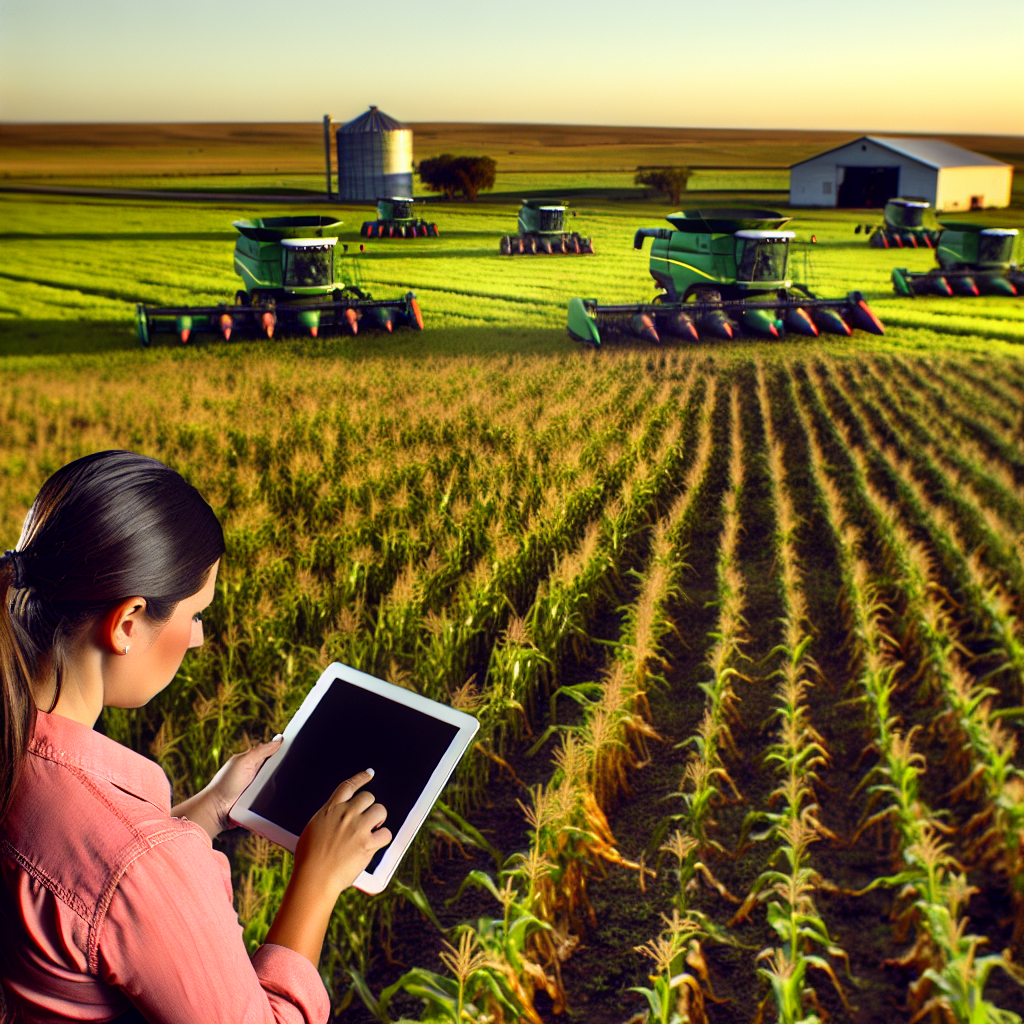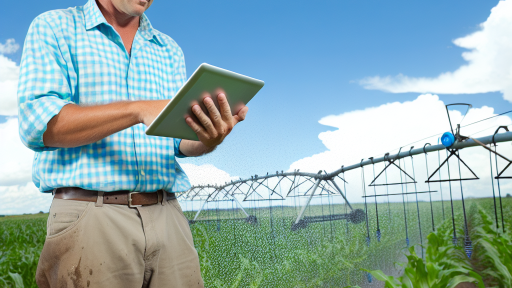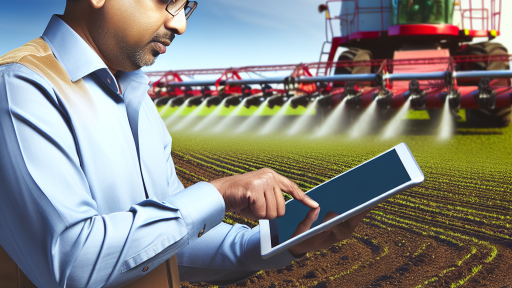Introduction to Automation in Agriculture
Automation plays a vital role in modern agriculture.
It enhances productivity and efficiency across farms.
Moreover, automation provides numerous benefits to farmers.
The Role of Technology in Farming
Technology transforms traditional farming practices.
Using advanced tools, farmers manage resources effectively.
Additionally, technology minimizes labor costs and time.
Benefits of Automation
- Increased production efficiency enhances output.
- Data-driven decisions improve crop management.
- Precision agriculture techniques optimize resource usage.
- Real-time monitoring ensures timely interventions.
Challenges in Implementing Automation
Implementing automation can pose challenges for farmers.
High initial costs may deter some from adopting new technologies.
Additionally, there’s a learning curve associated with new tools.
However, ongoing support can ease this transition.
Overview of Sensor Technology Used in Farming
Introduction to Sensor Technology
Sensor technology plays a vital role in modern agriculture.
It enables farmers to monitor various conditions on their farms.
Farmers can improve efficiency, yield, and sustainability using these tools.
Types of Sensors in Agriculture
Several types of sensors are utilized in farming today.
These include soil moisture sensors, weather stations, and crop health sensors.
Transform Your Agribusiness
Unlock your farm's potential with expert advice tailored to your needs. Get actionable steps that drive real results.
Get StartedSoil moisture sensors help farmers determine the right irrigation levels.
This ensures crops receive adequate water without wastage.
Weather stations provide real-time data on climatic conditions.
This information aids in planning and decision-making for farm operations.
Crop health sensors monitor plant conditions to detect diseases early.
By identifying issues quickly, farmers can take corrective actions.
Benefits of Using Sensors in Farming
Implementing sensor technology significantly benefits farmers.
First, it increases resource use efficiency.
Farmers can optimize water and fertilizer application.
Secondly, sensors enhance crop monitoring capabilities.
This leads to better yield predictions and management.
Furthermore, automation through sensors reduces manual labor.
As a result, farmers can focus on strategic decisions.
Challenges of Sensor Implementation
Despite their advantages, sensors also present challenges.
Initial setup costs can be high for many farmers.
Additionally, the integration of various sensors often proves complex.
Moreover, data management can overwhelm farmers lacking technical skills.
Support and training are critical for successful implementation.
Future Trends in Sensor Technology
The future of sensor technology in agriculture looks promising.
Advancements in IoT and AI will further enhance these systems.
Farmers will benefit from improved data analytics capabilities.
Moreover, we expect the development of even more specialized sensors.
These innovations will drive further efficiency and sustainability in farming.
Benefits of Automating Farm Operations
Enhanced Efficiency
Automating farm operations significantly increases efficiency.
Showcase Your Farming Business
Publish your professional farming services profile on our blog for a one-time fee of $200 and reach a dedicated audience of farmers and agribusiness owners.
Publish Your ProfileFarmers can allocate resources more effectively.
Automated systems streamline repetitive tasks.
Consequently, this reduces labor costs and saves time.
Improved Crop Management
Sensor technology allows for real-time monitoring of crops.
This facilitates timely interventions for pest control or irrigation.
As a result, farmers can enhance yields and minimize losses.
Moreover, precise data helps in making informed decisions.
Resource Conservation
Automation leads to better resource management on farms.
For example, sensors help optimize water usage.
This conserves vital resources and reduces waste.
Additionally, energy-efficient machinery lowers operational costs.
Data-Driven Insights
Sensors collect valuable data about farm conditions.
Farmers can analyze this data for improved decision-making.
Furthermore, predictive analytics helps foresee potential issues.
Such insights enable proactive measures to enhance productivity.
Enhanced Sustainability
Automated systems support sustainable farming practices.
By optimizing inputs, farmers minimize their environmental impact.
This approach fosters healthier ecosystems and biodiversity.
Additionally, sustainable practices attract conscientious consumers.
Learn More: Optimizing Water Use with Crop Monitoring Sensors
Types of Sensors Used in Agriculture
Soil Sensors
Soil sensors monitor moisture levels effectively.
They provide crucial data on pH and nutrient content.
Farmers can optimize irrigation based on real-time information.
This technology promotes water conservation practices.
Moreover, soil sensors help improve crop yields.
Weather Sensors
Weather sensors gather data on environmental conditions.
They measure temperature, humidity, and rainfall accurately.
This information allows farmers to make informed decisions.
Additionally, weather sensors help predict pest outbreaks.
Ultimately, they enable effective crop management strategies.
Livestock Sensors
Livestock sensors track animal health and behavior.
They monitor vital signs and activity levels continuously.
This technology assists in early disease detection.
Farmers can adjust feeding and breeding practices accordingly.
Furthermore, livestock sensors enhance overall farm productivity.
Discover More: Automated Harvesting Techniques Explained
Integrating Sensor Technology with Farm Management Systems
Overview of Sensor Technologies
Modern farms increasingly utilize sensor technologies to enhance productivity.
Various sensors monitor soil moisture, temperature, and crop health.
These devices provide real-time data for better decision-making.
Benefits of Integration
Integrating sensor technology with farm management systems offers key advantages.
Showcase Your Farming Business
Publish your professional farming services profile on our blog for a one-time fee of $200 and reach a dedicated audience of farmers and agribusiness owners.
Publish Your ProfileFirst, it streamlines data collection and analysis.
This integration improves resource allocation and reduces waste.
Moreover, it enhances crop monitoring and yield prediction.
Implementation Strategies
Effective integration requires a clear implementation strategy.
Farmers should first assess their specific needs and challenges.
Next, they can choose suitable sensor types for their operations.
Lastly, training staff on new technologies is crucial for success.
Data Management Approaches
Proper data management maximizes the benefits of sensor technologies.
Utilizing cloud-based platforms often facilitates data storage and access.
Farm management systems can then analyze this data efficiently.
Automation tools can also help in processing the information gathered.
Case Studies in Sensor Integration
Successful case studies highlight the effectiveness of sensor integration.
For instance, Greenfield Ag implements soil sensors across their fields.
As a result, they successfully reduced water usage by 30%.
Additionally, Harvest Tech uses drones equipped with multispectral sensors.
This technology enhances their ability to assess crop health.
Future Perspectives
The future of agriculture lies in advanced sensor technologies.
Emerging technologies will likely improve data accuracy and connectivity.
Furthermore, artificial intelligence can enhance predictive analytics.
Investing in these technologies now will prepare farms for future demands.
Delve into the Subject: Integrating IoT in Precision Farming Operations

Case Studies: Successful Implementations of Sensor Technology
Agricultural Monitoring at Green Fields Farm
Green Fields Farm implemented soil moisture sensors across their 500-acre property.
This innovation allowed them to monitor moisture levels in real time.
As a result, they optimized their irrigation schedules.
Consequently, they reduced water usage by 30% over two growing seasons.
Pest Detection with Smart Sensors at Berry Hill Farms
Berry Hill Farms adopted a network of smart sensors to detect pest activity.
These sensors utilize machine learning to identify pest patterns.
Additionally, they sent real-time alerts to farmers’ mobile devices.
This approach improved their pest control strategies significantly.
Ultimately, it led to a 25% reduction in pesticide use.
Yield Prediction through Data Analytics at Harvest Moon Vineyards
Harvest Moon Vineyards integrated sensors to collect various environmental data.
They focused on temperature, humidity, and sunlight levels throughout the vineyard.
This data fed into predictive analytics models.
Farmers received accurate yield predictions well in advance.
Thus, they could optimize harvest planning and resource allocation.
Livestock Monitoring at Sunny Acres Ranch
Sunny Acres Ranch implemented wearable sensors for their livestock.
These sensors track health metrics like heart rate and activity levels.
As a result, they quickly identified sick animals for timely intervention.
This approach reduced livestock mortality rates significantly.
Farmers reported overall improved herd health as a result.
Showcase Your Farming Business
Publish your professional farming services profile on our blog for a one-time fee of $200 and reach a dedicated audience of farmers and agribusiness owners.
Publish Your ProfileClimate-Smart Agriculture at Riverbend Organic Farms
Riverbend Organic Farms used weather monitoring sensors to track local climate conditions.
This data enhanced their ability to respond to weather changes quickly.
Moreover, it informed their planting and harvesting schedules.
The improved approach resulted in better crop quality and quantity.
Farmers also gained valuable insights into sustainable practices.
You Might Also Like: Cost Benefits of Adopting Precision Agriculture
Challenges and Limitations of Sensor Automation in Farming
Technological Limitations
Sensor technology often faces compatibility issues with existing farm systems.
Many sensors lack standardization and can vary by manufacturer.
This inconsistency makes integration challenging for farmers.
Furthermore, limited connectivity can impede real-time data transmission.
Rural areas may struggle with poor internet availability, affecting sensor performance.
Cost Considerations
The initial investment for sensor systems is significant for many farmers.
While costs may lower over time, farmers must balance budgets carefully.
This investment includes not only sensors but also necessary infrastructure upgrades.
Additionally, ongoing maintenance and support costs can add up quickly.
Data Management Challenges
Managing large amounts of data generated by sensors can overwhelm farm operators.
Farmers need robust systems to analyze and interpret this data effectively.
This often requires specialized knowledge and skills that farmers may lack.
Moreover, data security remains a concern, with sensitive information at risk.
Environmental and Regulatory Factors
Sensor performance can be affected by varying environmental conditions.
Extreme weather can disrupt sensor functionality and reliability.
Regulatory compliance adds complexity to sensor usage and data collection.
Farmers must keep up with changing regulations related to data usage.
Human Factors
Resistance to change among farm workers can hinder technology adoption.
Many experienced farmers may prefer traditional methods over new technology.
Training programs are essential to encourage successful sensor implementation.
Additionally, farmers must understand how to interpret sensor data to make informed decisions.
Future Trends in Agricultural Automation and Sensor Technologies
Increased Use of IoT Devices
The Internet of Things (IoT) will revolutionize agriculture.
Farmers will adopt more IoT devices for monitoring conditions.
These devices will provide real-time data on soil, weather, and crops.
As a result, farmers can make informed decisions quickly.
Advanced Data Analytics
Data analytics will enhance precision farming practices.
Farmers will analyze large datasets for better yield predictions.
This analysis will improve crop management and resource allocation.
Consequently, farms will operate more efficiently.
Improved Crop Monitoring Technologies
Technologies like drones and satellite imagery will gain popularity.
Drones will allow for aerial monitoring of crop health.
Farmers can identify issues such as pests or diseases efficiently.
Similarly, satellite imagery can provide comprehensive field data.
Integration of Artificial Intelligence
Artificial intelligence (AI) will play a vital role in farming automation.
Showcase Your Farming Business
Publish your professional farming services profile on our blog for a one-time fee of $200 and reach a dedicated audience of farmers and agribusiness owners.
Publish Your ProfileAI algorithms will analyze sensor data for optimal farming strategies.
This technology will enhance crop yield and minimize waste.
Moreover, AI-driven robots will assist in planting and harvesting.
Enhancements in Soil Health Monitoring
Soil health will be a focal point in future farming practices.
Advanced sensors will monitor soil moisture and nutrient levels.
Farmers will receive actionable insights to improve soil management.
Ultimately, this will lead to healthier crops and better yields.
Agroecological Approaches
Farm automation will increasingly embrace agroecological methods.
This involves integrating traditional practices with modern technology.
Farmers will focus on sustainable methods to enhance biodiversity.
The use of sensors will help track ecological impacts on farms.
Development of Custom Solutions
Customization of agricultural technologies will become more prevalent.
Farmers will seek tailored solutions that meet specific needs.
As technologies evolve, manufacturers will offer adaptive solutions.
This trend will encourage innovation in agricultural practices.
Expanded Education and Training Opportunities
As technology advances, education in these areas will expand.
Training programs will teach farmers how to utilize new tools.
Workshops will cover sensor installation, data interpretation, and more.
Consequently, farmers will be better equipped to adopt innovations.
Additional Resources
Agriculture Innovation: 10 Tech Trends to Watch in 2023 …
Precision Agriculture: Benefits and Challenges for Technology …




